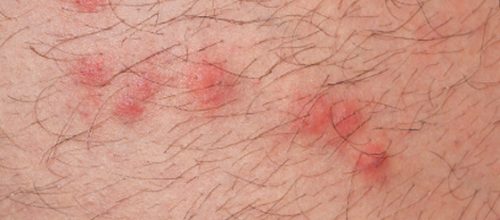Fleas are about 2mm long and dark red or brown in colour. They have six legs and are thin and flat.
You’re most likely to find them moving in your pet’s fur, but they may also be seen on your carpets or furnishings.
Another telltale sign your pet has fleas is if they have ‘flea dirt’ or droppings in their fur. This looks like tiny black dots, similar to ground pepper.
Treating your pets
Fleas are brought in to your house by your dog or cat, so if they’re infested you need to act quickly before the bugs spread around your home.
If they catch fleas, you can feed your pet flea tablets. These fast-acting pills put a flea-killing toxin into the animals blood – which is harmless to the pet, but means any flea which bites them will be killed in minutes.
You can also get spot-on flea drops, which you apply to your animal’s fur with a pipette. These work in a similar way to flea tablets, quickly killing the fleas on contact.
It is important to follow the instructions and dosages on any flea treatment for your pet.
Signs your pet has fleas
Excessive scratching or biting their skin
‘Flea dirt’ or droppings in their fur
Red bites or bumps on their skin
Pale gums
Home remedies for getting rid of fleas
For a home-made flea trap, fill a plate or shallow dish with a mix of water and dish soap, and put it next to a dim light source (like a night light) in rooms where you often get fleas. At night, the fleas will be attracted to the light, jump into the water, and get stuck in the liquid.
Cleaning up
Many people are unaware that they should treat their home after their pets suffer an infestation.
More than 95% of fleas don’t live on animals, but in wood floor crevices, carpets and soft furnishings. And they can remain alive in the cracks for up to two years.
So it’s important to get cleaning.
You should regularly wash pet bedding to get rid of flea eggs and larvae, but also make sure you’re washing the other soft furnishings where they sleep (even if they’re not allowed to!). That means sofa coverings and bedsheets too.
You should also get the vacuum cleaner out regularly. Fleas prefer dark areas where dirt and debris gather – under the sofa, in-between sofa cushions, floorboard crevices, skirting boards, and curtains. Rugs and mats are also classic breeding grounds, and places pets like to take a nap.
Flea sprays are available which you can apply to your carpets and furniture to kill fleas (but make sure you follow the instructions carefully).
If your pet spends a lot of time in your car, it’s also worth giving that a good clean too.
Facts
One flea will lay up to 25 eggs per day (approximately 800 in its life)
Fleas develop from egg to larvae to pupae to adults in 18-26 days (depending on temperature)
Fleas can only lay eggs after taking blood from the host animal they are living on
Approximately 90-95% of the fleas are cat fleas
Flea eggs and pupae are not affected by insecticides – this last fact is very important to understand after your home has been treated
Pets

Dog Flea

Flea Dirt

Flea Allergy

Up close
Can Humans Get Fleas?
Humans can get fleas. Once fleas invade a house they can bite both pets and humans. If you are the victim of a flea bite here is what you can do:
- wash the bite
- use an antiseptic and apply an icepack
- resist the urge to scratch
- lotions maybe used to treat the itch
- consult a pharmacist about antihistamines
Should your bite wounds excrete puss, contact your doctor immediately.

Flea bites on humans

Good day! Do you know if they make any plugins to help
with SEO? I’m trying to get my blog to rank for some targeted
keywords but I’m not seeing very good gains. If you know of any
please share. Cheers! I saw similar blog here: Auto Approve List
Hello! Do you know if they make any plugins to assist with SEO?
I’m trying to get my blog to rank for some targeted keywords but I’m not seeing
very good gains. If you know of any please share.
Appreciate it! You can read similar art here: Dobry sklep
You are in point of fact a good webmaster. The web site loading
pace is amazing. It kind of feels that you are doing
any unique trick. Also, the contents are masterpiece. you’ve performed a magnificent process in this matter!
Similar here: sklep online and also here: Sklep internetowy